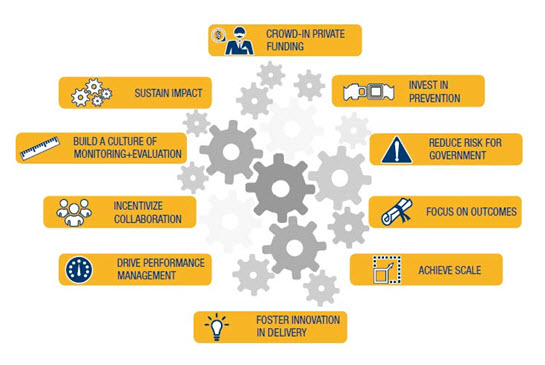Editor’s Note: This blog post is one in a series of posts in which guest bloggers respond to the Brookings paper, “The potential and limitations of impact bonds: Lessons from the first five years of experience worldwide.”
Social impact bonds (SIBs) are one of a number of new “Payment by Results” financing mechanisms available for social services. In a SIB, private investors provide upfront capital for a social service, and government pays investors based on the outcomes of the service. If the intervention does not achieve outcomes, the government does not pay investors at all. The provision of upfront capital differentiates SIBs from other Payment by Results contracts.
Development Impact Bonds (DIBs) are a variation of SIBs, where the outcome funder is a third party, such as a foundation or development assistance agency, rather than the government. To date, 47 SIBs and one DIB have been implemented in the sectors of social welfare (21), employment (17), criminal recidivism (4), education (4), and health (2).
How do SIBs stack up?
In a recent Brookings study, drawing from interviews with stakeholders in each of the 38 SIBs contracted as of March 1, 2015, we evaluate 10 common claims of the impact bond literature to date, so far made up of published thought-pieces and interview-based reports.
Figure 1. Common claims about Social Impact Bonds

Source: The Potential and Limitations of Impact Bonds: Lessons Learned from the First Five Years of Experience Worldwide, Brookings Institution, 2015.
Of the 10 common claims about impact bonds, we found five areas where the SIB mechanism had a demonstrable positive effect on service provision:
- Focus on outcomes. We found a significant shift in the focus of both government and service providers when it came to contracting and providing social services. Outcomes became the primary consideration in these contracts in which the repayment of the investment depended on achievement of those outcomes. Given that outcomes are the pivotal and defining piece of a SIB contract, it is unsurprising that many of those interviewed in the course of our research emphasized their importance, though we did find that this represented a more significant transformation in culture than expected.
- Build a culture of monitoring and evaluation. The outcome-based contract necessitates the collection of data on outcomes, which helps build a culture of monitoring and evaluation in provider organizations and government. We found that the SIB is beginning to help solve longstanding problems in systemic data collection in multiple instances. In turn, government evaluation of outcomes and obligation to pay only for successful outcomes provides transparency and value for taxpayers. However, it is too soon to tell whether the monitoring and evaluation systems will remain in place after the SIB contracts conclude.
- Drive performance management. The involvement of the investors and intermediaries in management of the service performance is a key component of SIBs. These private sector organizations often have stronger background in performance management and bring a valuable perspective to the social service sector. However, on average we find limited evidence that the service providers in SIBs to date have been able to significantly adjust their programs mid-contract in the case of poor outcomes, despite SIB proponents claiming this is one of the mechanism’s greatest merits.
- Foster collaboration. In addition to collaboration between the for-profit, nonprofit, and government sectors, we also find evidence of gridlock-breaking collaboration across government agencies, levels of government, and political parties due to SIB contracts. This was noted to be one of the most important aspects of SIBs but also one of the most challenging.
- Invest in prevention. External, upfront capital for services allows government to invest in preventive programs that greatly reduce spending in the future, such as early childhood development programs that reduce remedial education, crime, and unemployment. We found that all but one of the 38 SIBs were issued for preventive programs. Going forward, SIBs will not necessarily need to be tied to cash savings for government, but could simply be used as a method to finance programs that achieve desired social outcomes.
Where do SIBs currently fall short?
For the five remaining claims about SIBs, we found less evidence of impact.
- Achieve scale. Of the 38 impact bonds contracted as of March 1, 2015, 25 served less than 1,000 beneficiaries. The largest impact bond, the SIB to reduce criminal recidivism at Rikers Island Prison in New York City, aimed to reach up to 10,000 individuals, but was terminated a year early this July because it did not meet target outcomes. The smallest SIB supports 22 homeless children and their mothers in the city of Saskatoon in Canada. These numbers are nowhere near the scale of the toughest problems facing the globe, where, for example, 59 million children are out of school. However, since March of 2015, two larger SIBs have been contracted, which may be an indication of increasing confidence in the mechanism. The Ways to Wellness SIB in the U.K. aims to improve long-term health conditions of over 11,000 beneficiaries and the first DIB launched plans to improve enrollment and learning outcomes of nearly 20,000 schoolchildren in Rajasthan, India. Further, the impact bond fund model used in the U.K. for 21 SIBs—where teams of service providers, intermediaries, and investors bid for SIB contracts based on a rate card of maximum payments per outcome government is willing to make—could be used to reach greater scale by contracting multiple SIBs at once. The largest of the impact bond funds, the Innovation Fund, reaches over 16,000 beneficiaries across 10 SIBs.
- Foster innovation in delivery, and
- Reduce risk for government. SIBs vary in the degree of innovation and risk to investors—SIBs based on more innovative programs pose a greater risk to investors and may have higher investment protection or greater potential returns to balance the risk. In our study we found that very few of the programs financed by SIBs were truly innovative in that they had never been tested before, but that many were innovative in that they applied interventions in new settings or in new combinations. The literature claims that SIBs reduce the risk to government of funding an innovative service (government pays nothing if outcomes aren’t achieved), but as of March of this year it did not seem that the programs were particularly risky. The SIB in Rikers Island Prison was one of the most innovative and risky, and the early termination of the deal was an important demonstration of the reduction in risk for government. The New York City Department of Correction did not pay anything in this case; instead the investor and foundation backing the investment paid for the program.
- Crowd-in private funding. Our research also shows mixed evidence on the power of impact bonds to crowd-in private funding, the fourth claim with unclear results. The literature up until now has claimed that impact bonds crowd-in private funding for social services by increasing the amount of money from traditional funding sources and bringing in new money from nontraditional sources. There is some evidence that traditional service funders, such as foundations, are increasing their contributions because of the opportunity to earn back what would otherwise have been a donation. Many of the current investors in impact bonds, Goldman Sachs for example, are indeed new actors in the space and their increased awareness of social service provision may be a benefit in and of itself. However, if a program is successful, government ultimately pays for the program. In this case, investors are solving a liquidity problem for government by providing upfront capital and not actually providing new money. Nonetheless, there is some evidence that paying only for proven outcomes has motivated the public sector to spend more on social services and that the external upfront capital has allowed government to shift spending from curative to preventive programs. Further, most programs thus far have been designed such that savings to the public sector are greater than payments to investors, resulting in a net increase in available public sector funds.
- Sustain impact. Finally, five years since the first impact bond, we have yet to see whether impact bonds will lead to sustained impact on the lives of beneficiaries beyond the impact bond contract duration. The existing literature states that impact bonds could lead to sustained impact by demonstrating to government that a sector or intervention type is worth funding or by improving the quality of programs by instilling a culture of outcome achievement, monitoring, and evaluation. However, the success of impact bonds depends on whether new efforts to streamline the contract development stage come to fruition and whether incentives for all parties are closely scrutinized.
The optimal financing mechanism for a social service will differ across issue area and local context, and we look forward to conducting more research in the field on the suitable characteristics for each tool.
The Brookings Institution is committed to quality, independence, and impact.
We are supported by a diverse array of funders. In line with our values and policies, each Brookings publication represents the sole views of its author(s).








Commentary
Perspectives on Impact Bonds: Putting the 10 common claims about Impact Bonds to the test
September 2, 2015